Packing for a motorcycle trip can be a mind-boggling task. As much as we would like to make our trip as comfortable as possible, space constraints on motorcycles do not allow us to bring much.
During my two-year journey, it took me around a month or two of packing and unpacking before I went, “Uhuh, these are what I need and this is how I want things to be kept.” I know that not everybody has the luxury of time to figure it all out, so here is some advice to help you cut down on trial and error.
In short, less is better! The last thing you want is trudging around with a heavily loaded motorcycle and carrying the load up and down everyday.
One of the the most common mistakes of fledgling travellers is to over-pack. Many of you are probably already familiar with the exasperation of bringing things that you ended up not using at all.
Before you start packing, consider these questions.
How many sets of clothes should I bring?
It does not matter if you are going for one week or two years. If you are not travelling for a fashion show, you do not need more than 3 or 4 sets of regular clothes and underwear. These are enough to rotate between wearing, washing and drying. Nobody gives a hoot if you are wearing the same clothes over and over again or even the same clothes from yesterday.
Opt for quick-drying materials and convertible clothing. Clothes made of Dri-Fit material, sports bras and bikinis tend to wick off water faster. My favourite are motocross jerseys. They are comfortable, airy, fast-drying and long-sleeved, so that the riding jacket does not stick to your skin.
Convertible travel pants offer the options of shorts or long trousers for different occasions. For the fashion-conscious, a pair of black jeans is versatile, looks smart-casual, is easily to match and hides dirt well.
I will share some on-the-road laundry tips in the next article.
Is there an alternative for this item?
If you are thinking of bringing a foldable chair for camping, first consider if there is anything in your existing pack list that fulfills the same purpose. Maybe the metal panniers can also serve as stools or tables. Opt for items that can do duty on different occasions. Look out for things that are multipurpose!
If you are going to be travelling across multiple seasons, choose to layer your clothes instead of bringing different weather-specific gear. I stashed some Uniqlo Heat Tech and Merino wool inner wear in my winter pack. During winter, I wore them under my regular summer clothes. They are light and dry fast. Instead of bringing a bulky winter jacket, I attached thermal liners under my windbreaker.
Do you really need it? Can you live without it?
Everyone has different travelling styles, purposes and levels of comfort. A tent would be unnecessary for those with the budget for hotels or who prefer more comfortable accommodations. However, it is essential for those who enjoy the outdoors and have a tight budget. A minimalist with an ascetic approach may ditch any smart electronic devices all together. A travel journalist may need his or her camera and laptop to work on the go.
One of the purposes of travelling is to get out of our comfort zones. If you are used to hugging your smelly bolster to sleep every night, can you try to sleep without it? There are many ways to work around the absence of something. When my smartphone and GPS were damaged, I just did what travellers did before the invention of GPS – ask around for directions. We adapt to alternatives.
If you are not sure if you need it, can you easily buy it?
This question is especially applicable to spare mechanical parts. Does your motorcycle have specific parts that tend to breakdown easily and are not easily available? If you anticipate some nuts and bolts to rattle off easily, just pack a few.
If you are going on a short trip, service the bike well and swap out old parts before setting off, so you do not need to carry them. If you are on a long trip, you will need to consider the possibility of needing that specific replacement part, its world-wide availability and the time you can spare to source for parts mid-journey.
For example, one spare part that I will never carry again is the engine cylinder block. It was given to me mid-way during the trip. The extra weight disrupted the luggage balance on my scooter and even resulted in a small accident. I carried the excess 5kg around for a year before I finally used it during an engine overhaul. On hindsight, it was probably better to spend time and money freighting in the cylinder block, than to lug it around for a year.
How often do you need it? Is it worth the weight?
A fellow motorcycle traveller once asked me if he should bring two tents – a 3-season tent, as well as a 4-season one which can withstand cold and snowfall during winter. The 4-season tent is much heavier and probably too hot for summer use. I asked him about the possibilities of him riding during the winter, and if he would really want to camp during the cold. Is it worthwhile to lug a additional, heavier tent around throughout the year, only to use it during one season? Or would it be better to pay for proper shelter and warmth while travelling during the winter months? Bear in mind that accommodation tends to be cheaper during the off-peak winter season. Again, weigh the probability of the item being used against the alternatives for it.
Weight distribution of luggage matters.
Six years ago, during my first ride to Thailand on my Vespa, my friend wheelied up a very steep incline and landed in the drain. The Vespa is built rear-heavy and light in the front. Loading more weight on the rear makes the Vespa a very good wheelie machine.
 Do ensure the balance of luggage on your motorcycle. Weight distribution affects the handling of your motorcycle. Try to keep the weight as centralised as possible. I made the mistake of carrying my heavy engine cylinder insecurely in the front, until I hit a rock.
Do ensure the balance of luggage on your motorcycle. Weight distribution affects the handling of your motorcycle. Try to keep the weight as centralised as possible. I made the mistake of carrying my heavy engine cylinder insecurely in the front, until I hit a rock.
Ensure that your luggage is tightly strapped to the bike in order to prevent them from skipping around on bumpy roads. Rok Straps are very neat accessories for strapping down bags to racks . I highly recommend them over hook-end bungee cords. If you have not heard of accidents involving bungee cords snapping back and injuring the eye, read this. Many thanks to Motology Store for sending me Roks Straps during my ride!
Developing a Packing System
A convenient packing system usually revolves around your daily riding routine and the usage-frequency of the items.
One tip is to compartmentalise your stuff according to how frequently they are used, and the occasions for usage. Below is a layout of the items on my scooter. Things that you need frequently should be kept easily accessible. If you are a serious photographer, you should probably keep your camera and tripod within quick reach.
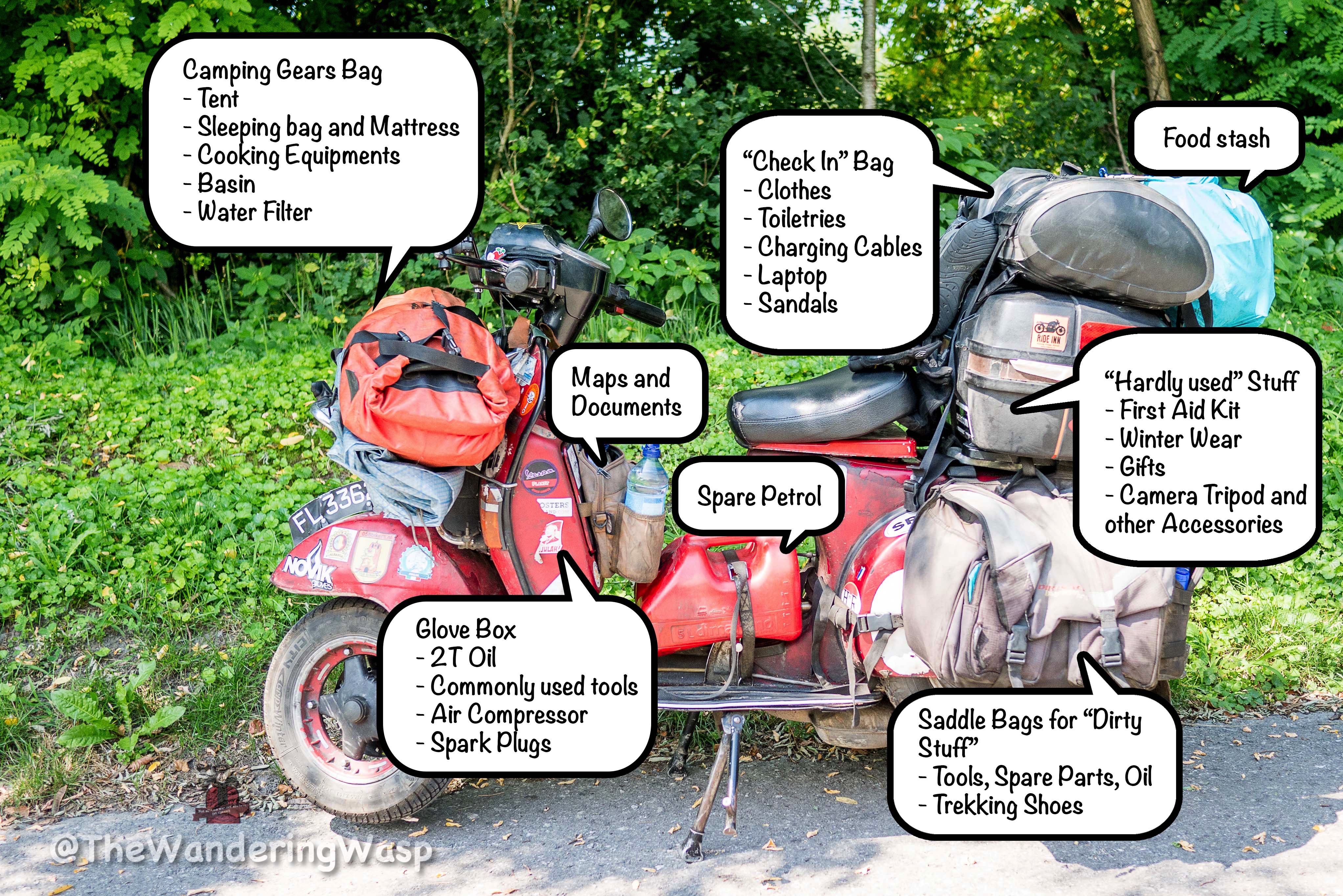
The “Check In” bag contains my valuables and day-to-day essentials. When I check into a hostel or my host’s home for the night, I simply carry the “Check In” bag. If I park my scooter and go trekking, this is also the bag I carry with me. The rest of the stuff are left on the scooter.
Don’t you secure your stuff?
Yes and no. In the best case scenario, all your belongings should be secured on the motorcycle. However, fully-lockable cases may not be a practical option on some motorcycles.
A thief does not want to risk being caught in the act in a crowded area. Try to park the motorcycle where there is human traffic or a security camera. If you cannot lock some stuff down securely, then at least make it difficult for anybody to take it away. Secure your stuff with a cable lock, or by tying some really complicated knots.
My expensive camping gears are secured with a PacSafe Backpack and Bag Protector. I always leave them on the scooter unless I am camping.
I do not secure my tools because they are pretty greasy and worthless. Besides, most tools are easily replaceable even if they get stolen.
Again, less is more. The less valuable stuff you carry around, the less you will have to worry about keeping them safe.
In the next article, I will share some useful accessories for long-term travel. Feel free to share any other tips in the comments below.


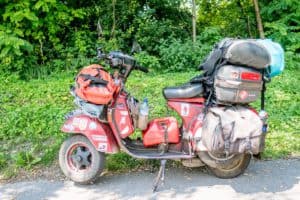
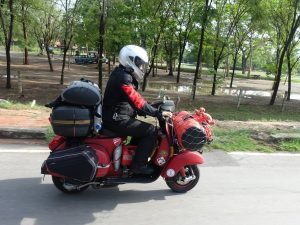
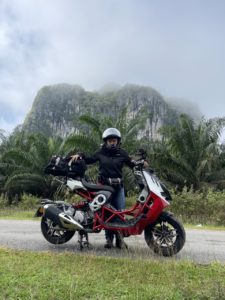
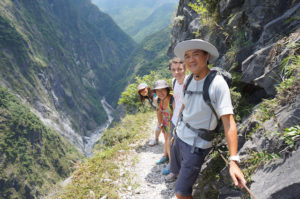
7 thoughts on “Packing tips for Motorcycle Travel”
I am not sure if I published the comment or not! 😛 I hit preview and the comment is gone. I dont want to double post, but in case I did delete it, Patrick is Jannick's brother! Awesome how small the 2 wheeled travel community is!
thank you very much. it is very helpful for my planning. 🙂
You are most welcome.
Awesome that you are sharing your experience.
Do you use a motorcycle cover to cover your scooter to keep a low profile and avoid theft of your belongings? What about a chain and lock? How do you secure your scooter at night or when you are away sightseeing?
Also, do you wear a protective armoured riding jacket and motorcycle pants when you ride?
Hi Chris, I do not have chain and lock. I do use a motorcycle cover at times. But once, it did not deter someone from trying to steal my scooter in Bonsia & Herzegovina. (My handlebar was broken.) My mistake was, I thought I parked in full view of the CCTV camera of the petrol station. But it was not. I admit I was quite complacent on securing my scooter because nothing happened in my 2 years of travelling. Bike theft is more common in the big cities (which I avoid) than in small villages. When my italian friend brought a big chain to secure both our scooter when we visited the city together, I thought it was quite over the board. But no, motorcycle theft is very common in big italian cities.
I had an alarm lock but it was damaged mid way the trip. I recommend using that, the loud noise is going to alert everybody in the surrounding. But some alarm locks are so sensitive that even the wind can trigger it.
Yes I wear armoured jacket anad pants, saved me many times.
Thanks Juvena for your inputs. You are truly an inspiration for all budding globe-trotting motorcyclists.
I've only done short rides (longest was 1 month), and I'm rather careful about securing my bike and wearing protective gear. But this routine gets rather tiresome and sometimes I feel like just throwing caution to the wind.
I look at many riders who speed around in T-shirt and shorts, and leave their bikes unsecured, and wonder if it would be better to be less paranoid. But I think if you can still be careful about your bike and safety after 2 years on the road, then surely I can do the same too.
You are taking a winter break, right? When will you continue your ride? Where do you intend to go next? And lastly, when will you end your ride? I'm curious and fascinated. Following your adventures makes me feel like I should have done the same when I was your age!